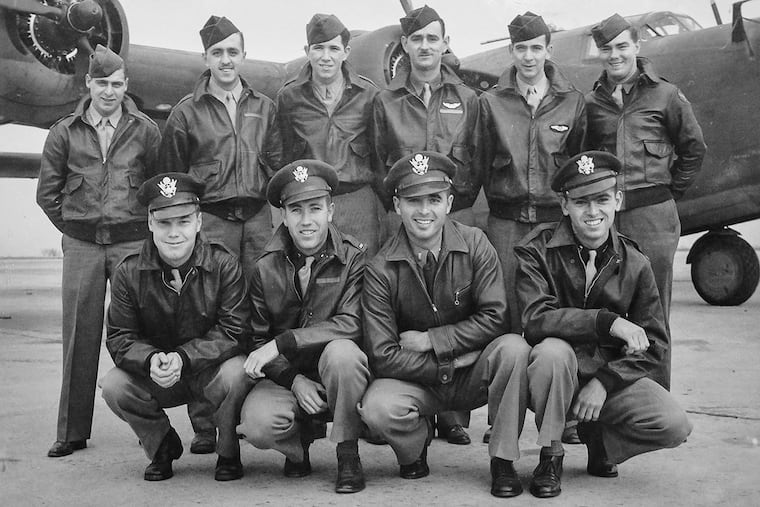World War II B-24 bomber found in South Pacific, 7 decades later
A University of Delaware oceanographer helped find the B-24, whose crew members included a 2nd lieutenant from Pennsylvania.

Hammered by Japanese anti-aircraft fire off the shores of New Guinea, the B-24 bomber became engulfed in flames, breaking apart in midair. The co-pilot gave one final salute before the plane plunged toward the waters of the South Pacific on March 11, 1944, as others watched in anguish from a nearby aircraft.
That was the last contact anyone had with the aircraft nicknamed "Heaven Can Wait" — until now.
Researchers announced this week that with a combination of underwater electronic gadgetry and old-school detective work, they had found the wreckage of the aircraft more than a mile out to sea.
Among the 11 servicemen who went down with the plane was 2nd Lt. Donald W. Sheppick of Roscoe, Pa., an hour south of Pittsburgh in Washington County.
"I was awestruck," said nephew Rich Sheppick, of Charleroi, Pa., after learning of the find. "This all was like a revelation."
The discovery was made in October by Project Recover, a partnership among researchers at the University of Delaware's College of Earth, Ocean, and Environment; the Scripps Institution of Oceanography at the University of California San Diego; and the nonprofit BentProp Project. The group then communicated its findings to the Pentagon agency that tracks missing servicemen.
Project Recover does not disclose whether any servicemen's remains have been recovered, deferring to the Pentagon. The team also generally is not cleared to contact family members, but in this case it was recently permitted to notify the family of 2nd Lt. Thomas V. Kelly Jr., which had contributed years of research that helped guide the quest for the plane.
The Kelly family researchers included Scott Althaus, a University of Illinois political scientist whose mother was Kelly's first cousin.
The family's 33-page dossier of findings, gleaned from diaries, archival records, maps, and emails with military buffs around the world, helped narrow down the plane's possible location, said Eric Terrill, a Scripps oceanographer and co-founder of Project Recover.
Like the oceanographers, Althaus was at first elated by the find. But then he was struck with emotion for a family member he never knew.
"We were grieving," Althaus said. "We had become invested in Tom Kelly's story. He's a member of the family now that he wasn't at the start of this journey, for me."
Althaus, whose research at Illinois includes studying public opinion of war, said he and his relatives have since notified the relatives of seven other crew members.
Project Recover was loosely established in 2012 with support from the Office of Naval Research, then formalized in 2016 with funds from Dan Friedkin, chairman and chief executive officer of the Friedkin Group, a consortium of automotive, hospitality, and entertainment companies.
To date, the team has identified 30 U.S. aircraft associated with 113 servicemen listed as missing in action in the Pacific and European theatres, Terrill said. In some cases that means verifying wreck sites that already were known to nearby inhabitants, while in others, such as the B-24 bomber, it means finding aircraft that have been lost since the war.
The information from the Kelly family included copies of eyewitness reports from others in the same bomber group — the famed Jolly Rogers, known for their skull-and-crossbones insignia on the tails of the aircraft.
Project Recover historians had come across some of the same records, but the independent confirmation and analysis by the family was invaluable, said Terrill and team co-founder Mark Moline, a University of Delaware oceanographer.
The researchers set off last fall for Hansa Bay, where they hoped to find the aircraft about a quarter-mile off shore of Papua New Guinea — the nation that now occupies the eastern half of the island.
The team moored its search boat near a small island in the bay and deployed four underwater robots — torpedo-shaped tracking devices that are programmed to roam back and forth, methodically scanning the ocean floor with beams of sonar.
The discovery came on the team's 11th day on the water, after the robots had scanned an area of more than 10 square miles. The wreckage turned out to be more than a mile out to sea, farther than the quarter-mile range that had been reported by eyewitnesses, but Terrill and Moline said perception of distance often is distorted by the chaos of war.
Once the apparent wreck site showed up on the sonar images, the team lowered a boxy, remote-controlled device into the water to capture the site on video. There was no question. It was the fuselage of Heaven Can Wait, sitting in more than 200 feet of water.
(A second aircraft with the same nickname, sponsored by actor Don Ameche after he appeared in a movie by that name, remains unfound.)
Next up for Project Recover is a trip to possible wreckage sites in Europe, followed by a mission to the Aleutian Islands in July.
In a few cases, the Pentagon has been able to identify the remains of servicemen in wreck sites identified by Project Recover. The agency then notifies family members and conducts memorial ceremonies.
But it is a vast undertaking. More than 70,000 U.S. service members from World War II remain unaccounted for.